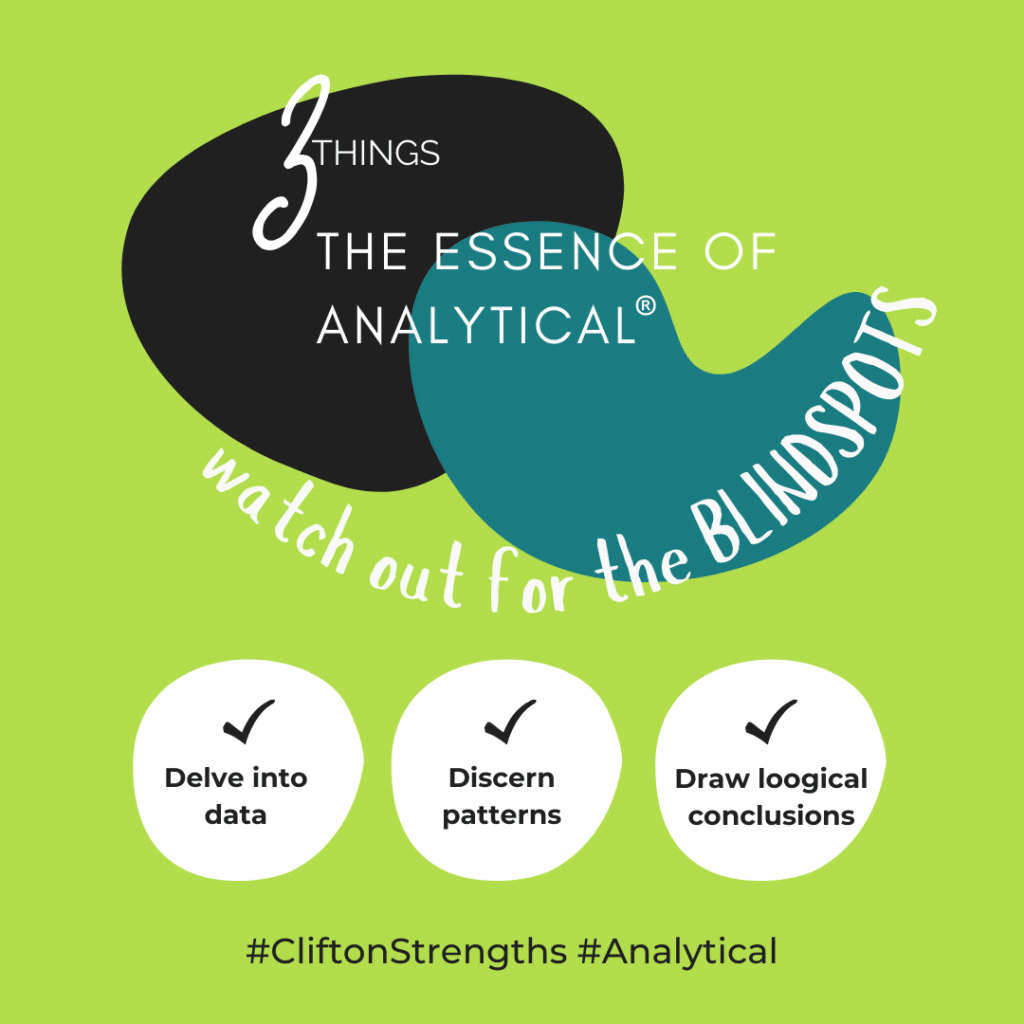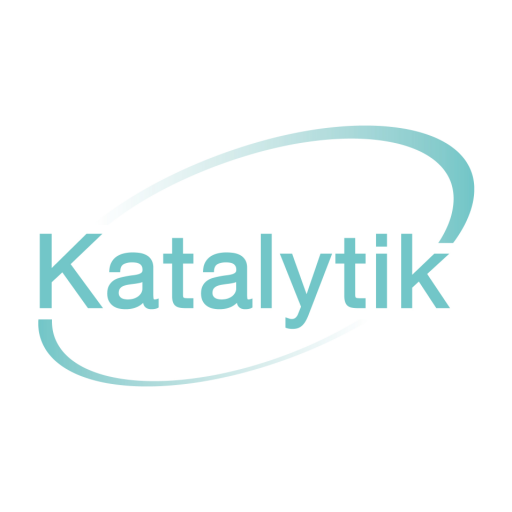
Common blind spots with CliftonStrength Analytical
This blogpost explores the common blndspots that occur when your ClifotnStrength Analytical strengths is dominant, and offers strategies to help mitigate any possible problems this can cause. The CliftonStrengths® assessment, developed by Gallup, identifies 34 distinct talent themes that individuals naturally exhibit. Among these, the Analytical® theme is highly valued for its ability to think critically, dissect complex problems, and make data-driven decisions. You will notice if a friend or colleague has Analytical® because they will be a source of many questions. However, like all strengths, Analytical® has its blind spots that can hinder both personal and professional growth if not managed effectively. This blog explores the potential blind spots of the Analytical® strength and offers strategies to mitigate them.
Of course, it can be easy to upset others with high Analytical® if you fail to realise this is a leading strength for them, by demanding further detail and data from them! Why do you think this is?
Individuals with a dominant Analytical® theme excel in understanding the reasons and causes behind situations. They enjoy data and facts, seeking patterns and correlations to make informed decisions. Their approach is methodical, objective, and logical, often leading to well-thought-out conclusions and solutions. However, this focus on analysis can sometimes lead to challenges, especially when interpersonal dynamics and emotional intelligence are required.ClifotnStrength

The Analytical® strength, with its emphasis on data and logic, is invaluable in many contexts. Awareness of the potential blind spots it brings you is crucial for maximizing your effectiveness. Developing a keener awareness of how others might receive your questions and demand for data, balancing detailed analysis with timely decision-making, embracing open-mindedness, maintaining a big-picture perspective, and simplifying communication, can enhance your contributions. Leveraging complementary strengths within a team can also ensure you bring a more inclusive approach to problem-solving and decision-making. Some suggestions are incorporated below.
Of course, it can be easy to upset others with high Analytical® if you fail to realise this is a leading strength for them, by demanding further detail and data from them! Why do you think this is?
Common blindsopts for people with a dominant Analytical® strength
I
Blind Spot 1: Overemphasis on data
Description: Analytical® individuals may prioritize data and factual information over intuition and emotional considerations. This can lead to decisions that, while logically sound, might lack sensitivity to the human element involved.
Example: In a team meeting, you might present a compelling argument based on data but overlook team members’ concerns or feelings about the proposed solution. This drive might mean you barely pause to listen or let others process the answer. Your certainty of the facts might also silence some.
Mitigation strategies:
- Incorporate emotional intelligence: Develop an awareness of others’ emotions and perspectives. This can be achieved through active listening and empathy, ensuring that decisions are both data-driven and considerate of team dynamics.
- Seek diverse input: Balance data analysis with input from colleagues who have strong relationship-building strengths. This can provide a more holistic view of the situation and lead to more inclusive decision-making.
Blind Spot 2: Paralysis by analysis
Description: The desire to thoroughly analyse every detail can result in decision-making delays, sometimes referred to as “paralysis by analysis.” This can be particularly problematic in fast-paced environments where timely decisions are crucial.
Example: An Analytical®-led manager might take too long to finalize a project plan because they are continually seeking additional data to validate their decisions.
Mitigation strategies:
- Set deadlines: Establish clear deadlines for decision-making to ensure that analysis does not become an endless process.
- Prioritize information: Focus on the most critical data points and learn to make decisions with incomplete information when necessary. Recognize that not every decision requires exhaustive analysis.
Blind Spot 3: Scepticism and cynicism
Description: Analytical®-led individuals often have a natural scepticism, questioning assumptions and seeking evidence. While this can lead to robust conclusions, it can also come across as cynicism, potentially demotivating team members or causing friction.
Example: During a brainstorming session, an Analytical®-led person might dismiss creative ideas too quickly if they don’t see immediate data to support them, stifling innovation.
Mitigation strategies:
- Embrace open-mindedness: Practice maintaining an open mind, especially during the early stages of idea generation. Encourage a culture of innovation by temporarily setting aside the need for immediate data validation. Look for ways to build a growth mindset.
- Build trust: Cultivate strong relationships with team members to ensure that scepticism is seen as a constructive part of the process rather than a barrier to creativity. Look to the Johari Window model.
Blind Spot 4: Overlooking big picture
Description: The focus on details and data can sometimes lead Analytical®-led individuals to miss the broader context or the long-term vision. They may get so engrossed in the minutiae that they lose sight of overarching goals and strategies.
Example: An Analytical® team member might perfect a specific process but fail to align it with the company’s strategic objectives, leading to inefficiencies in the larger scheme.
Mitigation strategies:
- Strategic partnerships: Collaborate with individuals who have a strong Strategic® or Futuristic® theme. They can help maintain focus on the big picture and ensure that detailed analysis supports broader goals.
- Regular reflection: Periodically step back to review how detailed tasks fit into the overall strategy. This can be facilitated through regular team meetings or personal reflection sessions.
Blind Spot 5: Communication® challenges
Description: Analytical®-led individuals often use technical language and detailed explanations, which can be overwhelming or confusing to those who prefer more straightforward communication.
Example: In a presentation, you might delve deeply into data specifics, losing the audience who may not be as data-savvy.
Mitigation strategies:
- Simplify communication: Learn to tailor messages to the audience. Use clear, concise language and highlight key points without overloading on data.
- Storytelling: Incorporate storytelling techniques to make data more relatable and engaging. This can help convey the significance of the information in a more accessible manner.
Ideas of other CliftonStrengths to partner with
The Analytical® strength brings a powerful ability to delve into data, discern patterns, and draw logical conclusions. To balance its potential blind spots and enhance overall effectiveness, partnering with complementary CliftonStrengths can create a more sensitive and balanced approach. Here are some strengths that pair well with Analytical®, along with how they can mitigate its blind spots:
1. Empathy®
Why it works: Empathy® brings the ability to sense the feelings and perspectives of others. This strength can help Analytical® individuals become more attuned to the human elements that data alone might miss.
Benefits:
- Enhances your emotional intelligence, helping to balance data-driven decisions with sensitivity to team members’ emotions.
- Fosters stronger interpersonal relationships, making it easier to build consensus and collaboration.
Example: During a project review, an Empathy® partner can highlight team concerns and emotional responses, ensuring that decisions consider both data and human impact.
2. Communication®
Why it works: Communication® is about expressing ideas clearly and effectively. It helps your Analytical® strengths in translating complex data into understandable and engaging narratives.
Benefits:
- Simplifies technical language and data-heavy explanations, making information more accessible to a wider audience.
- Enhances storytelling, making data insights more compelling and relatable.
Example: In a presentation, a Communication® partner can help distil intricate data points into key messages that resonate with non-technical stakeholders.
3. Strategic®
Why it works: Strategic® involves seeing patterns where others see complexity. Often simplifying things (and often doing this to too great an extent! Everything has blind spots!) This strength helps the Analytical-led person in envisioning long-term goals and aligning detailed analysis with broader objectives.
Benefits:
- Maintains focus on the big picture, ensuring that detailed Analytical® work supports overarching strategies.
- Provides direction, helping to prioritize data analysis efforts based on long-term goals.
Example: When planning a new initiative, a Strategic® partner can outline the vision and ensure that Analytical® insights are aligned with future aspirations.
4. Activator®
Why it works: Activator® as a strength is about turning thoughts into action. It helps counter the paralysis by analysis that Analytical® individuals might experience.
Benefits:
- Encourages timely decision-making, ensuring that analysis leads to actionable outcomes.
- Drives momentum, helping teams move forward without getting bogged down in excessive data scrutiny.
Example: During project planning, an Activator® partner can set clear deadlines for decision-making, ensuring that Analytical® insights lead to prompt actions.
5. Harmony®
Why it works: Harmony® seeks consensus and cooperation. This strength can help navigate the scepticism that Analytical® individuals might exhibit.
Benefits:
- Fosters a collaborative environment, reducing friction caused by scepticism or data-driven critiques.
- Balances Analytical® rigor with the need for team cohesion and agreement.
Example: In team discussions, a Harmony® partner can mediate between different viewpoints, ensuring that Analytical® critiques are constructive and lead to consensus.
6. Positivity®
Why it works: Positivity® brings enthusiasm and optimism. It helps mitigate the potential cynicism that can accompany a strong Analytical® approach.
Benefits:
- Infuses a positive outlook, encouraging a balanced view that considers both data and potential.
- Motivates teams, balancing Analytical® scrutiny with encouragement and support.
Example: In brainstorming sessions, a Positivity® partner can highlight the potential and opportunities in new ideas, ensuring that Analytical® scepticism doesn’t dampen innovation.
7. Adaptability®
Why it works: Adaptability® is about staying flexible and responding well to change. This strength helps Analytical® individuals remain agile in dynamic environments.
Benefits:
- Promotes flexibility, ensuring that data analysis adapts to changing circumstances and new information.
- Encourages a responsive approach, balancing thorough analysis with the ability to pivot as needed.
Example: During project implementation, an Adaptability® partner can help navigate unexpected changes, ensuring that Analytical® plans remain relevant and effective.
Conclusion
Analytical® creates blind spots for those with it high in their profile. These can hinder both personal and professional growth if not managed. In the first part we’ve explored 5 common blind spots, what this looks like, as well as offering two mitigation strategies for each blind spot. Partnering your Analytical® with other CliftonStrengths can enhance both individual and team performance. Indeed you may have one of these at the op of your profile. If so, intentional consideration of your thoughts and (in)actions strength-by-strength might support you in navigating your way forward.
We’ve explored Empathy®, Communication®, Strategic®, Activator®, Harmony®, Positivity®, and Adaptability®. Each of these bring unique benefits that address potential blind spots of Analytical®. By fostering collaboration with those who possess these strengths, can help you achieve a more balanced, effective, and holistic approach to problem-solving and decision-making. This synergy not only maximizes the potential of your Analytical® strength but also creates a more cohesive and dynamic working environment.
Why not visit our Powerful Strengths Facebook group and share how you leverage your Analytical® and keep it in a productive phase?
